A) How lighting effects camera techniques for moving image.
The lighting used in a scene can be highly effected by the kind of lighting that gets used in the scene and can be particularly effective for moving image by creating a certain mood for an audience to feel as stated in the second edition of Cinematography Theory and Practice by Blain Brown 2012, which says that "lighting can be used to affect the audiences perception of the scene". A way that an audiences mood can be altered is by the type of lighting used for example low key lighting created by little or no fill light and can be used to create a moody feel to the image, this king of lighting would also effect the camera technique used as it may need a higher aperture to make sure the whole image is in focus, this will also allow for and shadows cast to be clearer and sharper, Or it may need a low aperture to make sure the audience is focusing on what is particularly important in the scene rather than making out whats in the background, for example in the film Inception, low key lighting is used so that the audience is focusing on the characters face and used a low aperture in order to blur out the background so the audience is looking at whats most important in the scene.
Inception 2010 Christopher Nolan, Science Fiction/Thriller.
Another way that lighting effects the camera techniques is by altering the exposure that can be seen in an image as "the screen itself should be lit as evenly as possible", for example if using ambient lighting the exposure in the image can vary depending on how the light moves as its effected by natural light meaning that not he whole screen is evenly lit.. When using ambient lighting on a particularly sunny day the aperture and shutter speed may need to be low so that the camera doesn't become overly sensitive to the suns light and make sure that the image doesn't get overly exposed. This lighting extremely effects the camera techniques used in films such as social realism as ambient lighting is the main and in most cases the only way light gets used within the film. In the film Fish Tank the main lighting that gets used is ambient lighting and in the first scene one shot seems to be overexposed due to the changing ambient lighting, and can be seen as the shot appears more white than what it would look like in real life but then gets later corrected to the right exposure .
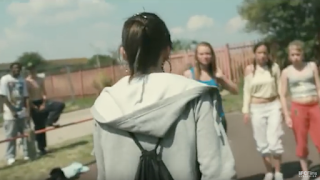 Fish Tank 2009, Andrea Arnold, Social realsim, slightly over exposed.
Fish Tank 2009, Andrea Arnold, Social realsim, slightly over exposed.Fish Tank 2009, Andrea Arnold, Social realsim, Correct exposure.
1) Blian Brown (2012), Lighting basics, Cinematography Theory and Practice Image Making for Cinematographers and Directors, Second edition, The Boulevard, Langford Lane, Kidlington, Oxford OX5 1BG UK, 2012, 106
2) Mitch Mitchell (2004), Sel-matting processes, Visual Effects for Film & Television, Linacare House, Jordan Hill, Oxford 0X2 8DP, 2004, 174
B) Lighting equipment and setups that would be used in the following scenarios...
1) A small documentary where portability is paramount
2) 'Talking head' style interview
If the interview is taking place outside then only ambient lighting and a diffuser may be used and if its a particularly sunny day in order to block out shadows and diffuse the light. A pro of this is that the audience may feel as though this is a realistic set up without artificial lighting however a con of this is that the diffuser may not completely block the shadows making the interview look less professional.
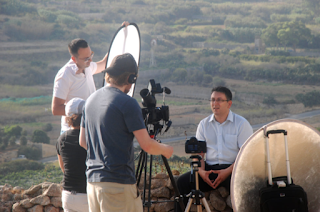
If the interview is taking place inside then a 3 point lighting method might be used, this is created by using a key light to highlight and add dimension to the person being interview, then followed by a fill light which can fill in the shadows that may be cast by the key light and lastly followed by the backlight which can separate the person being interviewed from the background behind them. A pro of this is that all shadows will be cast out and the set up will look much more professional however a con of this is that you may need to be wary of the heat given off from the lights and make sure that the subject doesn't get too hot and overheated.
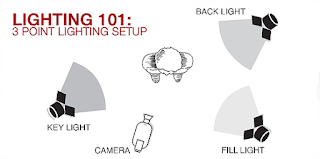
3) A 'Night time shoot'
For a night time shoot reflectors may be used to reflect the light that is avaliable at night to help light up the scene, they are also good for lighting up a night time shoot by correcting the colour given of from the moon, often blue reflectors are used to do this, they can also be used to make sure the light is focused on the subject to show the audience what is most important within the shot. However reflects may not also be available and may not always be available to light up the scene, in some cases white card may be used.
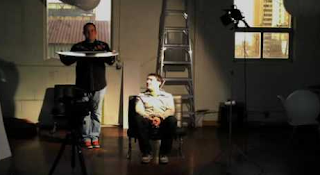
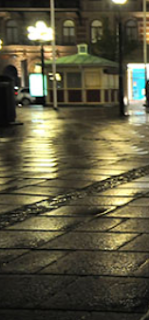
Another way to set up for a nighttime shoot is by using water to light up the scene as it can be used for a good reflector especially in urban areas where is reflects street lights or neon signs, water can create a highly reflective surface and lighten up the scene massively without the use for in some cases rather expensive lights. A pro of this is that water is usually high available and reduces the need to buy bigger lights however a con of this is that water may not be powerful enough to light the whole scene so some other lights may be needed to help solve this issue.


No comments:
Post a Comment